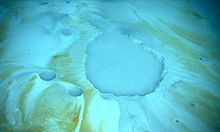
Back بحيرة تحت سطح البحر Arabic Llac submarí Catalan Unterwasser-Solebecken German Lac de saumure French Podvodno slano jezero Croatian Ստորջրյա աղի լիճ Armenian Kolam air asin ID Lago sottomarino Italian 塩水溜まり Japanese Lago submarino Portuguese



A brine pool, sometimes called an underwater lake, deepwater or brine lake, is a volume of brine collected in a seafloor depression. These pools are dense bodies of water that have a salinity that is typically three to eight times greater than the surrounding ocean. Brine pools are commonly found below polar sea ice and in the deep ocean. This below-sea ice forms through a process called brine rejection.[1] For deep-sea brine pools, salt is necessary to increase the salinity gradient. The salt can come from one of two processes: the dissolution of large salt deposits through salt tectonics[2] or geothermally-heated brine issued from tectonic spreading centers.[3]
The brine often contains high concentrations of hydrogen sulfide and methane, which provide energy to chemosynthetic organisms that live near the pool. These creatures are often extremophiles and symbionts.[4][5] Deep-sea and polar brine pools are toxic to marine animals due to their high salinity and anoxic properties,[1] which can ultimately lead to toxic shock and possibly death.
- ^ a b Kvitek, Rikk (February 1998). "Black pools of death: Hypoxic, brine-filled ice gouge depressions become lethal traps for benthic organisms in a shallow Arctic embayment". Marine Ecology Progress Series. 162: 1–10. Bibcode:1998MEPS..162....1K. doi:10.3354/meps162001 – via ResearchGate.
- ^ "NOAA Ocean Explorer: Gulf of Mexico 2002". oceanexplorer.noaa.gov. Retrieved 2020-09-28.
- ^ Salem, Mohamed (2017-06-01). "Study of Conrad and Shaban deep brines, Red Sea, using bathymetric, parasound and seismic surveys". NRIAG Journal of Astronomy and Geophysics. 6 (1): 90–96. Bibcode:2017JAsGe...6...90S. doi:10.1016/j.nrjag.2017.04.003. S2CID 132353952.
- ^ Extremophile life near brine pools Archived November 10, 2006, at the Wayback Machine
- ^ Eder, W; Jahnke, LL; Schmidt, M; Huber, R (July 2001). "Microbial diversity of the brine-seawater interface of the Kebrit Deep, Red Sea, studied via 16S rRNA gene sequences and cultivation methods". Appl. Environ. Microbiol. 67 (7): 3077–85. Bibcode:2001ApEnM..67.3077E. doi:10.1128/AEM.67.7.3077-3085.2001. PMC 92984. PMID 11425725.